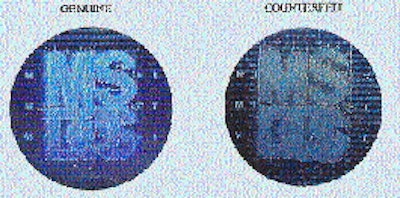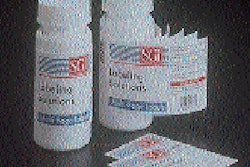If they hold up, recent decisions in federal appeals courts will signal an "open season" on national brand packaging. In response, private label marketers will be scrambling to get decades- old trademarks in their crosshairs. Foreshadowing the hunt was a September 21, 1994 decision by the U.S. Court of Appeals for the Federal Circuit. It reversed the "trade dress" finding of a federal district court in Missouri. The district court had said that Venture department stores was guilty of copying the packaging of Chesebrough-Pond's newly-designed but still distinctive yellow bottle for Vaseline® Intensive Care® Lotion. Though Venture's container looked much like the Vaseline container, Venture had its own black & white striped logo-which the Appeals Court called "distinctive"- on its private brand bottle, as well as wording suggesting the customer compare the Venture product to national brands. In reversing the district court, the Appeals Court concluded that there was no way a consumer could confuse the Venture container with that of Chesebrough's Vaseline. After Chesebrough requested a rehearing from the U.S. Court of Appeals, the court affirmed in December the decision it handed down in September. From that time, Chesebrough had 60 days to determine whether it wanted to seek a review from the U.S. Supreme Court. As PW went to press, Chesebrough said it had not yet decided. Five days after the first Vaseline decision, the U.S. Supreme Court agreed to hear an appeal of a decision made by the 9th Circuit Court of Appeals in California. That court had earlier ruled that Qualitex Co. could not get a trademark on the green-gold color of its Sun Glow press pad, which is used by dry cleaners. The Chesebrough decision bodes ill for Procter & Gamble, which has filed a similar case against two private label manufacturers of shampoos and deoderants, and against a national drugstore chain, F&M (see PW, Oct. '94, p. 10). "If the Chesebrough decision stands up, it will mean that private label companies can intentionally-and you should underline the word intentionally-go after a leading company's trade dress and develop a package intentionally close to it, and no legal action can be taken," argues a disgruntled Joseph Dreitler, a member of the board of directors of the International Trademark Association, and a lawyer at Anheuser-Busch. He also has served in Procter & Gamble's legal department. Dreitler explains that up until just a few years ago, major packaged goods manufacturers did not take private label brands seriously. That was because those store brands used "shlocky" packaging. That is no longer the case. Other products too Packaging imitation doesn't just affect national brand marketers of personal care products. Jeff Nedelman, a spokesman for the Grocery Manufacturers of America says, "Trade dress gets a lot of attention when the industry gets together." It is fair to say, however, that the national brand companies themselves sharpened the knife that is now poised at their throats. Many of these firms have had an incestuous relationship with private label manufacturers for many years. Prior to its launch of new packaging in 1989, Chesebrough-Pond's had supplied its yellow bottles unlabeled to Benjamin Ansehl Co., St. Louis, MO. Ansehl, in turn, filled those bottles with its own private-label skin lotion, and labeled those filled bottles for retailers like Target and Venture for sale in their stores. Eileen Sharkey, a spokeswoman for Chesebrough, declines to discuss her company's relationship with Ansehl, or the Appeals Court decision. In fact, in the Vaseline case, it was the Ansehl company-not Venture or any of the retailers-that took the initiative to redesign its private-label bottle once it caught wind of the Vaseline bottle redesign. Ansehl joined forces with a company called Kessler Containers, Ltd., (St. Louis, MO) and gave the specifications for the bottle it wanted to Kessler. Then Ansehl took that redesigned bottle and looked for retailers who would carry it. P&G's similar case On their face, the details in the Chesebrough case seem similar to those in the case involving Procter & Gamble. P&G sued F&M Distributors, Warren, MI, operators of 127 retail drugstores, in early September. P&G alleged that F&M sells private brand shampoo, cleansing cream and deodorants in packaging much too similar to P&G brands such as Pantene® Pro-V, Head & Shoulders®, Secret® and Sure®. This was the first time P&G had ever sued a retailer over trade dress. P&G had previously sued Perrigo Co., Allegan, MI, and Evron Industries, Chicago, IL, two companies that play the same marketplace role as Ansehl. P&G spokeswoman Carol Boyd did not return phone calls. Paul Kilmer, the Washington, D.C. attorney who handled the appeal for Ansehl, argues that Chesebrough was on very shaky grounds since it never objected to private label products prior to 1989, and in fact even aided in their marketing. The difference this time, surmises Kilmer, was that the early 1990s were a time of recession, and national brands were taking a beating in the market. "The national brands created the monster," Kilmer says, "and then it got out of hand." In fact, Kilmer advances the novel notion that Chesebrough repackaged Vaseline in an effort to bait private label companies into following suit, so that Ansehl and others could be sued under trademark laws. Chesebrough was "lying in wait," according to Kilmer. Kilmer suggests that Chesebrough would have won the case had it done what the Ross Products Division of Abbott Laboratories, Columbus, OH, did. On July 15, 1994, Donald Nickey, the division patent counsel, sent a letter to John McIntyre, president of the Paperboard Packaging Council. Nickey said that Ross had recently become aware of corrugated boxmakers that were illegally printing Similac® and Isomil® trademarks on boxes. Nickey said the company views that action as infringement, and it would take legal action. He asked McIntyre to tell the association members about Ross's concerns. What had been happening is that companies or individuals go into a discount store such as Wal-Mart or Ames and buy six or 12-packs of Similac and Isomil when sold as loss leaders. Those discount prices are often significantly cheaper than even wholesale prices. The pirates would carry out as many packages as possible, put them in a truck, drive somewhere, separate the cans from the Ross box, then repackage them in a second box, have it stamped with the correct but illegal trademarks, and sell the six-pack at a profitable price. Nickey says that the response from legitimate corrugated boxmakers has been good. "They have given us some names," he says. "The industry has been very responsive." Packaging piracy-lawful or not-bedevils national brands outside the U.S., too. International in scope Earlier this year, for example, J. Sainsbury Plc, a retailer in Great Britain that sells Coke through its 341 stores, agreed to make changes in the lettering on cans and plastic bottles of its own brand of cola. Coca-Cola had protested that the Sainsbury lettering and colors mimicked that of Coca-Cola Classic. Sainsbury ultimately agreed to change the lettering for "cola" and eliminate its underlining of the word "Classic." But Sainsbury refused to accede to Coke on the bottle/can color issue; and Coke's vehemence was constrained by Sainsbury's sales of Coke's own product. A more egregious example of trade dress deceit was the 220ꯠ packages of counterfeit MS-DOS 5.0 operating software from Microsoft Corp, Redmond, WA, sold in China. The counterfeiters had even applied counterfeit holograms to these packages. Don Mallik, vice president of Applied Physics Research (Atlanta, GA), was involved in examinining those holograms. "Some of the software boxes looked better than the ones Microsoft used," he says. "They copied the Microsoft packaging down to the Tyvek envelope for the disc." Tyvek is manufactured by DuPont Co. (Wilmington, DE). Microsoft filed a suit for $22 million in 1992 against the Shenzhen Reflective Institute, a company affiliated with a government university in an economic "free-zone" in Guangdong Province. Initially, China awarded Microsoft $450 in damages. When the company complained, China bumped up the award to $5ꯠ. Appeals are still going on. Alison Gilligan, a senior anti-piracy specialist for Microsoft, says, "If you put our package next to theirs, you would think something was off, but you wouldn't know which one was the real thing." She explains that Chinese packagers use a lot of recycled paper, which they heavily bleach, so their white colors are whiter than those in the U.S. China has a particularly poor record protecting trademarks of U.S. companies. President Clinton had until the end of 1994 to determine whether China had improved its intellectual property protection for imports. This evaluation is part of what is called a "Super 301" investigation. Should Clinton decide that China has done too little, he could impose sanctions on Chinese imports to the U.S. Microsoft's Gilligan says the company has had similar problems in other countries, but that the governments there have been much more responsive than China in awarding substantial penalties. c Stephen Barlas is a Washington, DC-area journalist working on special assignment for Packaging World.


























